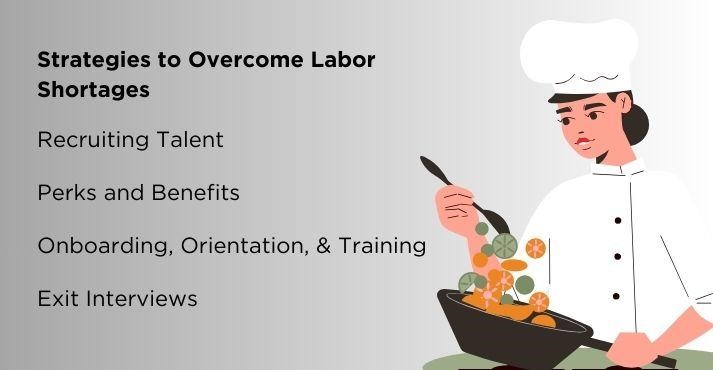The food service industry is no stranger to changes and challenges, especially after the turbulences experienced during the COVID-19 pandemic.
Even though businesses are back to normal, several problems in the food service industry remain to be addressed.
With shifting priorities, labor shortages, safety concerns, and changing consumer demands, issues and challenges faced by the food and beverage industry must be tackled effectively to ensure smooth operations.
This blog post will explore the 9 most significant problems facing the food service industry.
Let’s explore the challenges in the food industry and solutions one by one.
Top 9 Issues in the Food Service Industry

Whether you’re an aspiring restaurateur or food service owner seeking to take your business to the next level, you need to understand the common problems in the hospitality industry and their solutions to thrive in this ever-evolving sector.
1. Labor Shortages and Staffing Issues
One of the biggest problems the food service industry encounters is labor shortages and staffing issues.
From high turnover rates to difficulty attracting new workers, demanding working conditions, and limited benefits, hotel labor shortages adversely impact restaurants and establishments. The shortages create issues in service quality, delay orders, and strain existing staff.
Food service industry jobs are low-paying and don’t offer career advancement opportunities, making it less attractive for potential employees. This leads to high turnover rates and difficulty in recruiting and retaining workers.
Another reason for the staffing shortage is the need for health insurance, sick leave, or other benefits expected in other industries. It leads to an increase in absenteeism and further exacerbates the staffing shortage.
Also, job security is another major issue that causes labor shortage, as the workers in the industry are employed on a part-time or temporary basis. It makes it difficult for labor and staff and makes them less likely to stay in the industry for the long term.
To overcome this, food service establishments must create a more stable and sustainable workforce by improving strategies to boost labor productivity and attract staff.

Here are a few strategies to overcome this challenge:
- Recruiting Talent: Actively seek skilled individuals through targeted recruitment efforts, tapping into diverse channels to attract qualified candidates.
- Onboarding, Orientation, and Training: Streamline efficient onboarding processes, comprehensive orientations, and ongoing hospitality training programs to integrate new hires into the team. It ensures a smooth transition and accelerates their productivity.
- Perks and Benefits: Offer enticing perks and benefits packages, including competitive wages, healthcare, flexible schedules, and employee discounts. These incentives enhance job satisfaction and loyalty, attracting and retaining valuable staff in the competitive food service sector.
- Exit Interviews: Conduct thorough exit interviews to understand reasons for employee departures. Analyzing feedback provides valuable insights, allowing businesses to address underlying issues, enhance workplace conditions, and refine industry talent retention strategies.
Moreover, technology and automation can help the food service industry by enabling efficient and productive hotel operations management. For example, automating repetitive tasks and reducing labor requirements allows staff to handle large volumes of work.
2. Rising Food Costs
Over the past two years, food costs have almost doubled. Inflation is prevalent for everyone and has dramatically impacted the hospitality industry.
Food production costs increased due to labor turnover, investments, food safety and regulations, Climate changes, and supply chain disruptions due to ongoing tensions between Russia and Ukraine. All these factors directly impact the hotel pricing strategy and food costs for the establishments.
Despite the recovery from the pandemic, the establishment hasn’t been able to recover from labor shortages.
This persistent labor shortage is due to the aging population worldwide, workers transitioning to stable sectors due to unprecedented challenges during the pandemic, stringent immigration policies, low wages, and technology skill gaps.
According to the World Economic Outlook, a 1 percent drop in global harvests raises food commodity prices by 8.5 percent, and a 1 percent increase in oil prices increases food commodity prices by 0.2 percent.
Moreover, the rising food costs can be attributed to climate changes and supply chain disruptions due to ongoing tensions between Russia and Ukraine.
As global temperatures rise and weather patterns become more unpredictable, NASA has predicted that greenhouse gas emissions will continue to rise at the current rate; maize yields are projected to decline by 24% by 2030.
The Russia-Ukraine war has caused significant disruptions to global food systems, altering trade patterns, production, and consumption of commodities. The conflict in Ukraine is shaking essential pillars of the global food system in an already precarious context.
To overcome the rising food costs challenge, the food service industry can implement the following strategies:
- Menu Optimization: Regularly review and adjust menus to incorporate cost-effective ingredients while maintaining quality and without compromising customer satisfaction or dining experience.
- Supplier Negotiations: Engage proactively with suppliers to secure favorable pricing, bulk discounts, and long-term contracts.
- Inventory Management: Implement precise inventory tracking systems to minimize waste, control overstocking, and identify cost-effective alternatives. Streamlining inventory processes optimizes resources and reduces the financial strain caused by escalating food costs.
- Technology Integration: Leverage technology for automated procurement, inventory tracking, and data analytics. Advanced systems enhance efficiency, identify cost-saving opportunities, and empower informed decision-making, helping the food service industry adapt to fluctuating food prices.
3. Stringent Food Safety Regulations

Food safety refers to preparing, handling, and storing food meant to prevent foodborne illness and injury.
Maintaining food safety during every stage of food production is essential in the food service industry. Meeting standards demands constant adaptation to changing regulations, which strains resources and staff training.
Critical problems and challenges include cross-contamination risks, inadequate hygiene practices, and improper storage.
Insufficient staff training on proper food handling and sanitation procedures can lead to contamination and foodborne illnesses. Leaving cooked or ready-to-eat foods at room temperature for more than four hours.
Inconsistent temperature control during food preparation and storage poses a significant hazard. Additionally, supply chain complexities may introduce risks such as contaminated ingredients. Inadequate cleaning and sanitization of kitchen equipment and surfaces further compound these issues.
To overcome food safety, food service establishments must comply with the regulations and laws for food safety. Regularly monitor and audit the supply chain for quality and safety. Comply with food safety regulations, conduct routine inspections, and promptly address non-compliance.
4. Food Waste Problem

Food waste is one of the most common problems in the food service industry.
When disposed of in landfills, food waste produces harmful greenhouse gases such as methane and carbon dioxide, contributing to global warming and climate change. Food loss and waste undermine the sustainability of our food systems.
According to the report by the United Nations, globally, around 13 percent of food produced is lost between harvest and retail. An estimated 17 percent of global food production is wasted in households, food service, and retail.
The four most common reasons for food waste in food service industry include:
- Food can become unfit for consumption due to improper handling, storage, or packaging.
- Incorrect or inconsistent kitchen training can lead to larger portion sizes than planned.
- A server drops a food tray in the dining room, or a cook accidentally knocks over their cutting board.
- Refires occurs when a plate of food is sent back to the kitchen and needs to be remade.
To overcome the food waste problem, food service establishments can consider the following ways:
- Proper Food Storage: Efficiently store perishables using a first-in, first-out system. Proper temperature control and labeling ensure freshness, reducing waste and preserving food quality. Also, use sustainable food service equipment.
- Track the Popularity of Your Dishes: Focus on popular dishes to minimize overproduction, reduce food waste, and enhance sustainability.
- Calculate and Control Inventory: Implement a precise inventory management system to avoid overordering. Regularly assess stock levels, adjust ordering patterns, and reduce excess inventory.
- Repurpose Ingredients: Transform unused items into new dishes or specials, enhancing menu variety.
- Weekly Specials: Introduce specials to use surplus ingredients, add excitement to the menu, and minimize wastage.
- Offer Takeout Containers: Provide eco-friendly containers for leftovers, encouraging customers to take home unfinished meals.
- Reducing Food Waste by Compost: By turning food scraps into nutrient-rich compost, the food service industry contributes to environmental sustainability, closing the loop on the food waste cycle.
It’s no wonder the food service industry is under immense pressure; therefore, by implementing these strategies, you can reduce food waste and ensure sustainability.
5. Technology Integration in Food Service Operations

Integrating technology into traditional food service establishments improves hotel operations but has several challenges. Resistance to change among staff can hinder the adoption of new systems, requiring comprehensive training and support.
Moreover, upfront costs for implementing technology, such as point-of-sale systems or automated ordering platforms, may strain budgets for small food service operators. Maintaining data security and privacy due to increasing reliance on digital transactions.
Food service establishments can implement the following strategies to overcome these challenges for smooth technology integration.
- Digitalization: Technology integration can help reduce manual errors and enhance efficiency. Digital menus, ordering systems, and payment options improve customer experience.
- Contactless Hospitality: Contactless services, like mobile check-ins and virtual concierge, minimize physical interactions and enhance the hospitality guest experience. It not only addresses health concerns but also eases the transition to technology.
- Online Ordering Systems: Implementing user-friendly online ordering systems reduces order errors, expedites service, and encourages technology adoption, especially for takeout or delivery.
- Data Security: Prioritizing data security measures instills customer and operator confidence. Protecting sensitive information from breaches builds trust.
6. Food Supply Chain Disruptions
Since the pandemic, food supply chain disruptions have significantly impacted the industry, with the Russia-Ukraine war further exacerbating the challenges.
From farmers and field workers to food manufacturers and service operators, the global pandemic is causing problems at every stage of the supply chain.
Fluctuations in commodity prices increased financial pressures for businesses, affecting their ability to source ingredients. Logistics face disruptions due to transportation issues, border closures, and labor shortages, leading to delays in receiving and distributing products.
Food supply chain disruptions, one of the biggest problems in the food industry, require immediate attention and solutions.
Food service establishments can implement the following strategies to prepare for and manage supply chain disruptions.
- Monitor Supply Chain Risks and Develop Contingency Plans: Assess potential disruptions, create a contingency plan, and proactively monitor operations to mitigate risks and maintain operational resilience.
- Adopt a Multi-sourcing Strategy: A multi-sourcing strategy enhances flexibility, ensuring a more resilient supply chain and minimizing the impact of disruptions on operations.
- De-prioritize Cost Efficiency: Balancing cost considerations with resilience measures ensures a sustainable supply chain capable of withstanding disruptions.
- Enhanced Visibility through Detailed Data: Detailed insights into inventory levels, supplier performance, and market trends empower informed decision-making, facilitating proactive measures against potential disruptions.
- Increased Use of Advanced Analytics: Analyzing data patterns helps anticipate supply chain challenges, enabling timely adjustments and adaptability.
7. Consumer Preferences and Changing Trends

Consumer behavior constantly evolves and changes. Rapid shifts in dietary choices, such as a growing demand for plant-based options or increased focus on sustainable sourcing, pose menu development challenges.
Technological trends, like the rise of food delivery Apps, impact the service models, necessitating adjustments in operational strategies.
Moreover, consumers are flocking to value and buying premium products and services. Health and wellness factors influence purchasing decisions and food service operations to adapt to the trend.
As a food service establishment, you can overcome these challenges:
- Adaptability: Success in the food service industry demands adaptability to shifting consumer preferences. Restaurants must adjust menus and strategies to meet evolving tastes and expectations.
- Menu Innovation: Introducing new flavors, dietary options, and trending cuisines captivates customers.
- Role of Social Media: Leveraging platforms for marketing, engaging with customers, and monitoring feedback to develop a direct connection.
As we look to the future of consumer trends in the food service industry, we expect to see significant changes and trends that will shape how businesses interact with their customers.
8. Competition and Market Saturation
The food service industry is incredibly competitive. Competition and market saturation can impact the food service industry for new entrants and established businesses. Market saturation can lead to price wars, eroding profit margins.
Adapting to changing consumer preferences and leveraging technology is imperative to sustain competitiveness in the industry.
With numerous choices available for the customers, their loyalty may be spread across multiple establishments. Striking a balance between quality, pricing, and unique offerings is a constant challenge.
Additionally, limited qualified staff may be available, as many restaurants compete for the same talent pool.
- Niche Specialization: Differentiate by specializing in a unique niche, such as a specific cuisine, dietary trend, or experience. This targeted approach attracts a specific customer base, reducing direct competition.
- Innovative Marketing Strategies: Utilize social media, partnerships, and loyalty programs to engage customers. Highlighting unique aspects of your offerings can cut through market saturation.
- Collaborations and Partnerships: Strategic partnerships broaden reach and create novel experiences. This attracts new customers and distinguishes your brand in a saturated market.
- Continuous Adaptation: Swiftly adapt menus, services, and technology to meet evolving customer expectations. Remaining responsive ensures sustained relevance and competitiveness in the food service industry.
With more competition than ever, the food service industry must execute strategies to survive the fierce competition.
9. Economic Uncertainty and External Factors
Economic downturns reduce consumer spending, impacting revenue. Geopolitical events, such as trade disputes, disrupt supply chains, leading to ingredient shortages and price fluctuations.
Global crises, like pandemics, pose unprecedented challenges, forcing closures, limiting trade disputes, disrupting supply chains, and leading to ingredient shortages and price fluctuations.
Adapting to fluctuating demand, managing supply chain disruptions, and regulatory changes become essential.
Overcoming economic uncertainties and external factors depends on resilient strategies such as:
- Diversify Revenue Streams: Expand beyond traditional dine-in services by offering takeout delivery and reducing reliance on a single source.
- Agile Supply Chain Management: Establish relationships with multiple suppliers and implement contingency plans to mitigate disruptions caused by geopolitical events or crises.
- Strategic Cost Management: Implement efficient inventory control, monitor expenses, and renegotiate contracts to maintain financial stability during economic uncertainty.
- Community Engagement and Loyalty Programs: Building a loyal customer base provides stability during economic downturns, ensuring sustained patronage in the face of external challenges.
- Continuous Market Analysis: Regularly analyze market dynamics, consumer behavior, and regulatory changes to adjust strategies, ensuring resilience and adaptability proactively.
Conclusion
The food service industry faces several challenges and problems, from operational intricacies to external global factors.
These challenges require strategic and adaptive approaches, from supply chain disruptions and changing consumer preferences to economic uncertainties and fierce competition.
Moreover, labor shortages, wage pressures, and regulatory compliance add additional layers of complexity—market saturation and intense competition demand constant innovation, niche specialization, and creative marketing to stand out.
Also, the industry is affected by economic downturns, geopolitical events, and global crises, necessitating a resilient supply chain and diversified revenue streams.
So, if you want to remain relevant and operate efficiently, you need to address the problems in the food service industry. Correctly identifying these challenges can help you prepare and scale your business.











